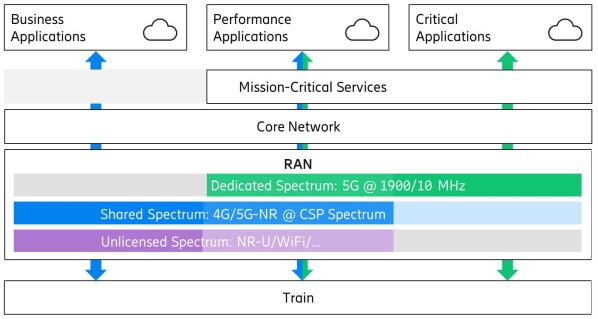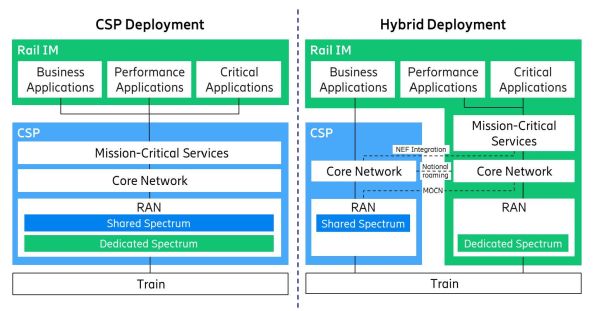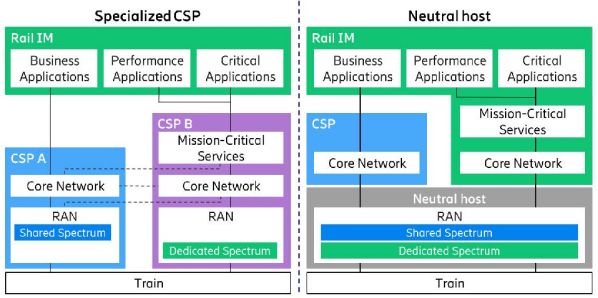For today’s and tomorrow’s digital railway, we need a signalling-based coordination, which enables strong optimisation and densification of train traffic, as well as further automation of rail transportation. This critical application depends on ubiquitous and consistent connectivity wherever the train travels. The railway’s communication network is therefore a crucial enabler for the control and real-time monitoring of trains and to maintain safe, efficient operations.
Railways have been allocated dedicated spectrum for safety-critical operations, but railway infrastructure managers (IMs) may be challenged to fulfill all their needs with only this spectrum available. While they can deploy a dedicated, stand-alone network using their allocated spectrum; additional spectrum will be required to serve all the foreseen applications and provide radio redundancy. One potential solution is for railways to collaborate with Communications Service Providers (CSPs) whose existing infrastructure can be reused. Railways and CSPs have a common interest to build out coverage along rail tracks. By sharing infrastructure primarily used for passenger connectivity, they both benefit from reduced investment.
Diverse railway services
Based on their criticality and purpose, communication services for digital rail operations can be grouped into three categories: critical communication, performance communication and business communication [source: UIC URS].
Critical communication, as defined in UIC URS, is required for “applications that are essential for train movements and safety or a legal obligation” such as emergency voice calls or Automatic Train Protection (ATP) that manages the safe movement of the train along its route. If critical communication services fail, the respective trains have to stop, leading to major delays in the train schedule. This is why high availability and resilience of these systems is of utmost importance.
Performance communication is required for “applications that help to improve the performance of the railway operation.” The purpose is to optimise and assist the rail operation - for example, by enabling live video surveillance for better situational awareness or telemetry data for anticipating and proactively handling potential infrastructure and train failures.
Business communication is required for “applications that support the railway business operation in general.” Business communication most notably includes internet access to passengers on trains and platforms, for social media, video streaming, checking train schedules, and other infotainment use cases.
The right type of spectrum for the right application
To offer network connectivity support for all these application types, railroads must provide 5G NR coverage in both dedicated railway spectrum and shared public spectrum owned by CSPs. While the dedicated spectrum is required primarily for critical applications, it can also carry traffic of performance applications as long as sufficient capacity is available. In cases where only 5G NR can provide the bandwidth required for both performance and business applications, shared public spectrum needs to be used. Finally, unlicensed spectrum can provide additional capacity for business applications that might be required at crowded areas such as stations.

Critical and performance applications are furthermore expected to make heavy use of the 3GPP-specified mission-critical services (MCS) for voice, video and data communication, providing required functionality on session establishment, authorization, location services and more.¹ All critical applications require a very high availability of the MC Services, the Core Network, and the Radio Access Network. Some applications also require ultra-reliable and low-latency communications. Consequently, the critical applications have stronger requirements for the underlying services and infrastructure than business applications, a factor to be considered when examining various deployment options.
Cost-effective network deployment and operation
While a railway IM can deploy and operate a network with dedicated spectrum, the shared public spectrum is typically managed by the network of the respective CSP that owns the spectrum. The reuse of existing mobile network infrastructure of CSPs, along with a collaborative approach to building new infrastructure, provides a fundamental cost advantage. The European countries have significant differences in size, population density, mobile network infrastructure, rail communications infrastructure, economy and regulation, leading to differences in collaborative approach. Despite their differences, countries can gain the same cost advantage through investments in new mobile network infrastructure with both dedicated and public spectrum. There are also different ways railway IMs and CSPs can collaborate towards a flexible and cost-effective network deployment.
The CSP-only approach
One straightforward approach is for the CSP to deploy and operate the complete communication system on behalf of the railway IM. The CSP has full flexibility when it comes to the configuration and optimization of the network, and the IM can leverage the CSP’s experience and expertise in network operations, while only hosting the applications.
The hybrid approaches
In more hybrid approaches, the IM can have a network of its own and integrate with a CSP’s network on various levels (for instance, national roaming, MOCN Multi-Operator Core Network or MC Services integrated with the CSP’s core network using the network exposure function/NEF). In this approach, the railway IM has full flexibility in the network configuration and optimization for the dedicated spectrum, and varying degrees of control for the shared public spectrum, depending on the integration model. The IM expects proper isolation for passenger, performance and critical communications traffic in CSP’s network using network slicing.

Mixed approaches
Finally, mixed approaches are also possible where, in some regions, the IM operates its own RAN while relying on CSP-deployed RAN in other regions. Also, third parties can play a significant role. A CSP specialized on private networks might operate a dedicated network on behalf of the IM, or a neutral host could operate a dedicated RAN along railway tracks for both the IM and one or more CSPs.

Collaborating towards 5G-powered rail operations across Europe
When rolling out wide area network for digital rail, a railway requires dedicated 5G spectrum or a dedicated network slice using CSP spectrum to guarantee service performance and availability for critical rail applications. Performance applications and some business applications demand 5G coverage of additional CSP-owned spectrum due to their need for high capacity. Unlicensed spectrum can complement other spectrum at stations and depots to cater to high-capacity and high-traffic demand. There are multiple deployment options, with varying degrees of control and responsibility on the Rail IMs and CSPs side. There is also room for other parties to fully leverage the potential of reducing the network deployment and operations cost.
Ericsson is ready to roll with you
Ericsson’s comprehensive portfolio and experience allow us to support all deployment options for railways, from fully dedicated to hybrid networks. As a vendor of RAN, Core Network and mission-critical network and services components, we offer a portfolio that allows for a tailor-made deployment and integration of subsystems with high availability. Catering to the country-specific environment in railway networks, we’re paving the way for fully 5G-supported rail operations across Europe.
Further readings:
- Blog: 5G will accelerate digital transformation journeys for railways
- White Paper: 5G-powered FRMCS- Achieve ubiquitous 5G connectivity on 1900 MHz for FRMCS
Page: Empowering rail with mission-critical 4G and 5G
¹Business applications can also make use of MCS when beneficial.
Author:


